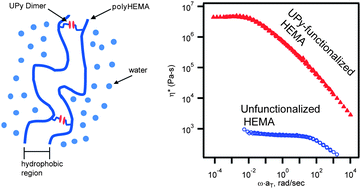Synthesis, swelling behavior, and viscoelastic properties of functional poly(hydroxyethyl methacrylate) with ureidopyrimidinone side-groups
Abstract
In this report the swelling and linear viscoelastic behavior of a hydrophilic

* Corresponding authors
a
University of Rochester, 250 Gavett Hall, Rochester, NY, USA
E-mail:
anthamatten@che.rochester.edu
Fax: +1 585 273-1348
Tel: +1 585 273-5526
In this report the swelling and linear viscoelastic behavior of a hydrophilic

 Please wait while we load your content...
Something went wrong. Try again?
Please wait while we load your content...
Something went wrong. Try again?
C. L. Lewis and M. Anthamatten, Soft Matter, 2013, 9, 4058 DOI: 10.1039/C3SM27735F
To request permission to reproduce material from this article, please go to the Copyright Clearance Center request page.
If you are an author contributing to an RSC publication, you do not need to request permission provided correct acknowledgement is given.
If you are the author of this article, you do not need to request permission to reproduce figures and diagrams provided correct acknowledgement is given. If you want to reproduce the whole article in a third-party publication (excluding your thesis/dissertation for which permission is not required) please go to the Copyright Clearance Center request page.
Read more about how to correctly acknowledge RSC content.
 Fetching data from CrossRef.
Fetching data from CrossRef.
This may take some time to load.
Loading related content
